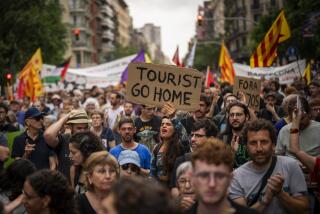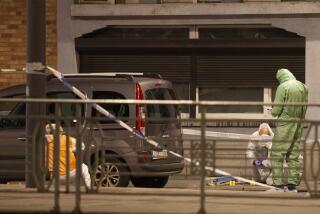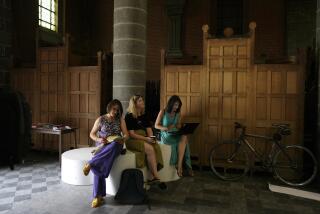Brussels Is a City Not to Be Ignored
- Share via
BRUSSELS — A savage rain squall had descended suddenly, sweeping the Grand Place, the city’s playfully elegant town center, clear of sightseers, ourselves among them.
What better excuse for a long and lazy lunch? This, our first morning in Brussels, should be the day to try what all the Belgian guidebooks say is a staple of the local diet: beer, mussels and frites.
I don’t want to diminish the importance of Brussels’s historic attractions, which are splendid, but the Belgian capital is a city where food really should dominate your daily itinerary.
One of the “favorite leisure pursuits” of the Belgians, advised the Sabena magazine in my airline seat pocket, “is eating.” Sabena is the Belgian national airline. I was about to do as the Belgians do.
The quality of food, I found, compares quite favorably to that in Paris, and generally (though not always) without Paris’ high prices. Entire streets in some neighborhoods are devoted to nothing but cafes, restaurants and ice cream shops.
It was down one of those streets that we headed, the Petite Rue des Bouchers, a narrow pedestrian passageway running off the Grand Place. It is one of Europe’s most unusual streets, lined the entire length of the block with one inviting restaurant after another, offering complete fixed-priced dinner menus for $15 to $25.
The rain poured heavily, but we were sheltered by canopies opened over each entranceway. Many places had set up elaborate window-front displays of fresh fish, fruit and vegetables, all on ice, to catch the lunch-crowd eye. We might have been at a busy outdoor market.
Which to choose? We selected Le Mouton d’Or, mostly because it had a cozy fire ablaze and we could see heaps of dark mussel shells on many of the tables. Good, flavorful beer is one of Belgium’s treasures, and we were quickly served two towering glasses.
I ordered mussels with white wine sauce, and my wife a variation with tomatoes, peppers and onions, neither of us quite sure what we would get.
A lunch of beer, mussels and frites is hardly gourmet fare, but I contend that the proof of a good restaurant is how well it manages its ordinary dishes. Le Mouton d’Or did wonderfully.
Our mussels arrived in good time, served in two huge black kettles, each pot large enough to simmer a week’s worth of soup. They must have contained four or five dozen mussels apiece (I stopped counting the shells after the first three dozen or so), all floating in a sauce rich with fresh vegetables and herbs.
A platter of frites , the slender French fries on which Belgians pride themselves, followed immediately, with bread to sop up the sauce. We ate through the rainstorm and then some, and relaxed a while longer with a cup of coffee.
The bill for two, tip included, was a reasonable $36. Eating, we decided, was going to be one of our favorite activities in Brussels.
Despite its culinary expertise, Brussels often is ignored by American tourists, perhaps because it is viewed as a modern city of commerce. While that is true, the city is anything but staid.
Most European capitals celebrate their castles and cathedrals. Brussels has its historic architecture too, but it cherishes the impudent little statue called “Mannekin Pis” depicting a chubby naked boy urinating into a fountain.
It’s a whimsical piece dating back to the 14th Century that reflects an underlying spirit of good times. When the shops and offices close, Brussels has fun.
The latest version of the statue, sculpted in bronze in 1619, stands about a block from the Grand Place, on Rue de l’Etuve.
To my list of the city’s special treats, which already includes good food and beer, should be added another exquisite temptation: chocolates. Belgium is a world capital of fine, handmade chocolates, and hardly a block in the center of the city doesn’t have one or two chocolatiers ready to sell you a single piece or a boxful.
To curb the mounting calories, we treated the chocolates as dessert, stopping in a different shop after each meal to sample just one or two creamy truffles and maybe a nut cluster. Our favorite shop was Wittamer in the Place du Grand Sablon, a charming old neighborhood only a short walk south from the Grand Place.
Wittamer, in fact, is two shops, a few doors from each other. One sells chocolates and the other is a gleamingly elegant patisserie offering luscious pastries and amazing ice cream creations. Eat a light lunch before this dessert.
Between meals we did manage a substantial amount of sightseeing, almost all of it on foot. Brussels is a good walking city. Every day we began at the Grand Place, the gorgeous heart of old Brussels.
The city’s principal square, it is ringed with sidewalk cafes and rivals the most beautiful plazas or squares anywhere in Europe. A colorful extravaganza of fanciful statuary, ornate columns and gold-leaf facades, it is a delicious, entertaining feast for the eyes.
Wealthy commercial guilds built their palatial headquarters around the square. Part of its beauty stems from architectural unity.
In 1695, Louis XIV bombarded Brussels, which was then ruled by Spain, destroying much of the square. City leaders rebuilt it with great care for aesthetics. Even if you are not a food fancier, the Grand Place is still worth a special trip to Brussels.
The dominant structures on the square are the Gothic Town Hall with its slender, soaring belfry, and the similarly Gothic Municipal Museum, which faces it from the other side of the square.
Much of Brussels is determinedly modern, but inside the square it is easy to imagine you have stepped back into the 17th Century. Wherever you look, the view is Gothic or Renaissance or baroque.
I enjoyed sitting in a cafe window sipping a beer and enjoying the square’s architectural curiosities. Some of the decorations are charming. The House of the Swan, once home of the butchers guild, is adorned with a large swan, but others are bizarre, depicting unusual methods of torture.
On that first rainy day in Brussels, we did not stray far from the Grand Place. At mid-morning, after a tour of the Municipal Museum, we snacked on apple and apricot tarts at La Chaloupe d’Or, once the house of the tailors and now a bustling coffeehouse and beer pub.
Confirmed sightseers ought to think of Brussels as a reward to themselves. Exhaust the museums of London, Paris and Amsterdam, then head for Brussels for a long weekend of good food and pleasant relaxation.
My favorite restaurant in our three-day stay was the charming and inexpensive Aux Armes de Bruxelles, also on Petite Rue des Bouchers.
It was crowded and noisy, the kind of old-style dining room where the waiters know most of the patrons and almost everyone sits elbow-to-elbow at communal tables for eight. The congenial banter between waiters and residents put to the lie a guidebook warning that the Petite Rue des Bouchers caters only to tourists.
All through the meal one waiter was kept busy making flaming crepes, each batch preceded by a fountain of fire that leaped for the ceiling. I expected someone to be charred momentarily, but the waiter knew what he was doing.
The food was as good as the room was colorful. I ordered a boneless chicken breast in an orange sauce, a dish that arrived rather fancily arranged in alternate orange and chicken slices. It was accompanied by potatoes Normandie, which looked like small crusty marshmallows, and a mixed salad of very fresh vegetables.
Belgian farmers are noted for the extremely high quality of their fruits and vegetables, and it is said that the Belgian consumer will accept nothing but the best. I ended the meal with a delicious praline souffle and coffee. My half of the dinner, a large beer and tip included, was $32.
The Brussels tourist office in the Town Hall sells an annual guide to the city’s restaurants, rating them both on quality and on value for the money. From one to five irises are awarded by a committee of Brussels’s best-known food critics.
If you are a stranger to the city, as we were, the guidebook (about 90 cents) is very helpful. Aux Armes de Bruxelles, good as it was, rated only a single iris.
One night we tried a three-iris restaurant, Trente Rue de la Paille, recommended by a friend who had lived recently in the city. Just off the lovely Place du Grand Sablon, it is a cozy spot with seating for no more than a couple of dozen diners.
The food was superb, but contrary to the rest of our experience in Brussels, it also was very expensive. An extra iris or two, it seems, can add considerably to the bill.
The menu was written on a blackboard, listing at most a handful of choices for a first and second course and dessert. An appetizer of artichoke hearts and diced tomatoes was not added to the bill but was included. The price, with wine and tip, was $90 per person.
Once I sniffed at travelers who returned home talking only of the fine food they had, but my wife put the matter into perspective.
I am fond of history, she noted, and enjoy pursuing historic paths, an activity she gladly shares during the day. But her hobby is fine cooking, and she loves to examine cookbooks. When she travels she wants to sample what the great chefs of the world are serving. So I follow her lead in the evening, hardly the worse for it.
My special interest was the small collection of works in the Museum of Ancient Art by the 16th-Century painter Pieter Brueghel, who lived in and is buried in Brussels.
With an innovative genius, Brueghel captured the everyday life of his time in such extraordinary works as “Winter Landscape with Skaters and Bird Trap,” which depicts young ice skaters on a village pond. It is a haunting painting.
One afternoon we made a pilgrimage to the Horta Museum, a tribute to Belgian architect Victor Horta, who pioneered art nouveau at the turn of this century. The style was very popular in Brussels, and the Town Hall tourist office distributes a list of 60 art nouveau structures still standing. It is at 25 Rue Americaine, about an hour’s brisk walk south from the Grand Place.
“A house should not merely be a reflection of its owner’s life style but should represent a portrait of him,” Horta once said.
The museum occupies two adjacent townhouses built by Horta in 1898. He lived in one and kept his office in the other. They are an artwork of swirling polished wood, gracefully curving ironwork, rich ballooning cabinetry, mosaic floors and stained glass of delicate tones.
One of Brussels’ finest residential and shopping areas, the Place du Grand Sablon, is south of the Grand Place in a neighborhood well worth spending some time.
There you will find Wittamer the chocolatier and some of the more expensive restaurants, including Trente Rue de la Paille. There are also numerous art galleries and antique shops, many of the latter lining Rue de Rollebeck--a steep, one-block cobblestone street leading to the square.
The focal point of the Grand Sablon is Petit Sablon, a beautiful Renaissance-style garden filled with statuary. A splendid wrought-iron fence encircles the garden, its posts topped by 48 bronze statuettes representing Brussels guilds. I found it fun trying to identify them.
Nearby is the 12th-Century Church of Notre Dame de la Chapelle, which shelters Breughel’s tomb.
Just north of the Grand Place are the three St. Hubert Royal Galleries, the first glass-covered shopping arcades built in Europe. Dating from 1846, they are the Gallery of the King, Gallery of the Queen and Gallery of the Princes.
Each is lined with boutiques, a few of them selling the handmade lacework for which Belgium is famous. Lace handkerchiefs are about $15 each; a box of Belgian chocolates begins at about $10.
In Brussels, the subject somehow always gets back to food, and I don’t want to omit yet one more edible treat to which I succumbed--the Belgian waffle.
Just across the street from our hotel entrance was a window-front waffle shop dispensing fresh-made hot waffle squares, heaped high with whipped cream and splashed with good Belgian chocolate sauce.
I consider it an act of strong will that I indulged only once--about an hour after I flew into town. But then, how else would I have managed the beer, the frites , the mussels, the apricot tarts and all the other delights awaiting me here?
More to Read
Sign up for The Wild
We’ll help you find the best places to hike, bike and run, as well as the perfect silent spots for meditation and yoga.
You may occasionally receive promotional content from the Los Angeles Times.






